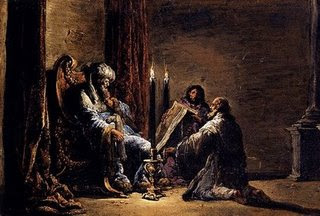The book of Genesis tells of the appearance of the Lord to Adam and Eve after they had partaken of the fruit of the Tree of Knowledge of Good and Evil. The Lord mentions some of the consequences of their action and pronounces a curse upon Satan who had taken it upon himself to convince Adam and Eve to eat the fruit. This is what the Lord said:
Genesis 3:14-15
"And the Lord God said unto the serpent, Because thou hast done this, thou art cursed above all cattle, and above every beast of the field; upon thy belly shalt thou go, and dust shalt thou eat all the days of thy life:
"And I will put enmity between thee and the woman, and between thy seed and her seed; he shall bruise thy head, and thou shalt bruise his heel."
In verse 15 the pronoun "he" refers to the Savior. The Savior bruised the head of the serpent when he carried out the Atonement and freed all people from the bonds of physical death and made entrance into God's kingdom possible on conditions of repentance. The serpent bruised the heel of Jesus Christ when he induced the Jewish authorities of the day to have the Savior crucified.
An injury to the head is far more serious than an injury to one's heel. Implicit in verse 15 of Genesis 3 is that the Savior's wound would be temporary and relatively minor while the wound inflicted upon Satan would be severe and permanent.
Additionally, it is possible that this story alludes to the manner in which the Savior's heel would be bruised.
Jesus Christ is the most famous of all the victims of crucifixion. Crucifixion is known to have been practiced by numerous different cultures at numerous different times but the Romans have become the most famous practitioners of this horrific form of execution.
Most artwork of the crucifixion of Jesus Christ depicts the Savior hanging from the cross with nails driven through the palm of each hand and through the top of each foot. Unfortunately archaeological evidence of crucifixion is scarce and the manner in which it was carried out has been a matter of speculation.
In 1968, however, an ossuary was discovered in Jerusalem which contained the bones of a victim of crucifixion. The name of the person was Yehohanan ben Hagkol. Other than his name and manner of death not much else is known about this individual. Despite the relative anonymity of this man his remains hold great significance for students of the New Testament. His remains date to the approximate time of Jesus Christ so they provide clues about the methods the Romans used when they carried out the crucifixion of the Savior.
Typically the nails used in a crucifixion were extracted from the victim and re-used due to the scarcity of iron. However, it appears that when ben Hagkol was crucified one of the nails driven into his feet hit a knot in the wood which caused the tip of the nail to bend making it difficult to remove. When ben Hagkol was removed from the cross the crucifiers evidently cut out the portion of wood into which this nail was driven and buried him with the nail still embedded in his foot. When ben Hagkol's remains were discovered the nail was still firmly attached to his foot. Interestingly the nail was driven not through the top of the foot but perpendicularly through the heel. Pictured below is a photograph of the heel bone through which the nail can be seen.

In the figure below an artist's depiction illustrates how the feet were attached to the cross.

It is possible, therefore, that when Jesus Christ was crucified the Romans drove the nails through his heel bones as they did when crucifying Yehohanan ben Hagkol. If this was the case then perhaps the passage in Genesis chapter 3 referring to the Atonement of Jesus Christ also refers to the manner in which the Savior was to be sacrificed.
Of course there is no way to know this for certain and the exact method used to crucify Jesus Christ is not the central message of Genesis 3:15. The central message is that the Messiah would come to earth, suffer and die on behalf of all mankind and be resurrected so that we can all be resurrected and enjoy the blessings of Eternal Life through repentance.

